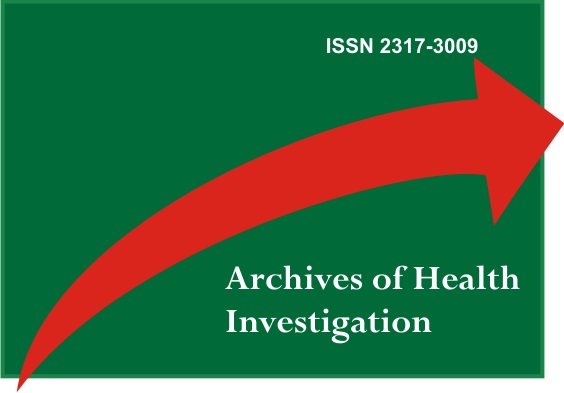Association between malocclusion and oral health status in patients treated at the Dental Clinics of the State University of Rio Grande do Norte, Brazil
DOI:
https://doi.org/10.21270/archi.v11i1.5414Keywords:
Malocclusion, Oral Health, Dental Caries, ChildAbstract
Introduction: A high rate of malocclusion and caries injuries is observed in children and adolescents, however the interaction between both still causes divergences in the scientific world. Objective: To investigate the possible association between malocclusion and oral health condition. Material and Methods: This cross-sectional and retrospective study was carried out based on the evaluation of medical records of patients aged 8 to 16 attended at the Dental Clinics of the State University of Rio Grande do Norte - Brazil, between the years 2013 to 2019between the years 2013 to 2019. The sample consisted of 135 patient records divided into 4 distinct groups: patients with Class I malocclusion (Group 1), Class II malocclusion (Group 2), Class III malocclusion (Group 3) and patients with normal occlusion (Group 4). To assess the oral health condition, information was collected on the DMFT and its components and for the identification of malocclusion, the anteroposterior relationship of the first permanent molars was used. To check the possible associations between the DMFT and the type of malocclusion, the Chi-square test was used, as well as the one-way ANOVA to compare the caries experience between the groups, with a significance of 5%. Results: There was no greater experience of caries within each group, just as there was no difference between groups for oral health condition. Conclusion: The oral health condition assessed by the caries experience is not associated with the presence or absence of malocclusion when the anteroposterior molar relationship is assessed.
Downloads
References
Sousa RV, Pinto-Monteiro AKA, Martins CC, Granville-Garcia AF, Paiva SM. Malocclusion and socioeconomic indicators in primary dentition. Braz Oral Res. 2014;28(1):1-7.
Bastos JL, Nomura LH, Peres MA. Dental pain, socioeconomic status, and dental caries in young male adults from southern Brazil. Cad. saúde publica. 2005;21:1416-23.
Castilho ARF, MialheI FL, Barbosa TS, Puppin-RontaniI RM. Influência do ambiente familiar sobre a saúde bucal de crianças: uma revisão sistemática. J Pediatr. 2013; 89:116-123.
Nowak AJ. Paradigm shift: infant oral health care – primary prevention. J Dent. 2011;39:49-55.
Cavalcanti AL, Bezerra PKM, Alencar CRB, Moura C. Prevalência de Maloclusão em Escolares de 6 a 12 Anos de Idade em Campina Grande, PB, Brasil. Pesq Bras Odontoped Clín Integr. 2008;8(1):99-104.
Guzzo SC, Finkler M, Reibnitz Júnior C, Reibnitz MT. Ortodontia preventiva e interceptativa na rede de atenção básica do SUS: perspectiva dos cirurgiões-dentistas da Prefeitura Municipal de Florianópolis, Brasil. Ciênc saúde coletiva. 2014;19.
Dutra SR, Pretti H, Martins MT, Bendo CB, Vale MP. Impact of malocclusion on the quality of life of children aged 8 to 10 years. Dental Press J Orhod. 2018;23(2):46-53.
Borzabadi-Farahani A, Eslamipour F, Asgari I. Association between orthodontic treatment need and caries experience. Acta Odontol Scand. 2011;69:2–11.
Baskaradoss JK, Geevarghese A, Roger C, Thaliath A. Prevalence of malocclusion and its relationship with caries among school children aged 11 - 15 years in southern India. Korean J Orthod. 2013;43(1):35.
Sá-Pinto AC, Rego TM, Marques LS, Martins CC, Ramos-Jorge ML, Ramos-Jorge J. Association between malocclusion and dental caries in adolescents: a systematic review and meta-analysis. Eur Arch Paediatr Dent. 2018;19(2):73-82.
Gábris K, Márton S, Madléna M. Prevalence of malocclusions in Hungarian adolescents. Eur J Orthod. 2006;28:467-70.
Frazão P, Narvai PC. Socio-environmental factors associated with dental occlusion in adolescents. Am J Orthod Dent Orthop. 2006;16:129:809.
Nobile CGA, Paiva M, Fortunato L, Angelillo IF. Prevalence and factors related to malocclusion and orthodontic treatment need in children and adolescents in Italy. Eur J Public Health. 2007;17:637-41.
Mtaya M, Brudvik P, Astrøm A. Prevalence of malocclusion and its relationship with socio-demographic factors, dental caries, and oral hygiene in 12- to 14-year-old Tanzanian schoolchildren. Eur J Orthod. 2009;31:467-76.
Kinnear TC, Taylor JR. Marketing research: an applied aproach. Mc Graw Hill. 1979.
Cons NC, Jenny J, Kohout FJ. Dai--the Dental Aesthetic Index. Iowa City, Iowa, USA: College of Dentistry, University of Iowa, 1986. Print.
Mitchell, L. An Introdution to orthodontics. 3. ed. New York: Oxford University Press Inc; 2007.
Becky Chiang-Lin Liu, I-Chen Lee, Lun-Jou Lo, Ellen Wen-Ching Ko. Investigate the oral health impact and quality of life on patients with malocclusion of different treatment needs. Biomed J. 2019;42(6):422-29
Baume LJ. Uniform methods for the epidemiologic assessment of malocclusion. Am J Orthod. 1974;63(3):251-72.
Farsi NMA.,Salama FS. Caracteristics of primary dentition occlusion in a group of Saudi children. Int J Paediatr Dent.1996;6:253-259.
Infante PF. Malocclusion in the deciduous dentition in white, black and apache Indian children. Angle Orthod. 1975;3:213-18
Kerosuo H. Occlusion in the primary and early mixed dentitions in a group of Tanzanian and Finnish children. J Dent Child. 1990;4:293-98.
Trottman A.; Elsbach HG. Comparison of malocclusion in preschool back and white children. Am J Orthod Dentofac Orthop. 1996; 110(1):69-82.
Woon KC. Primary dentition occlusion in Chinese, Indian and Malay groups in Malaysia. Aust Orthod.1988;10(3):183-85.
Klein H, Palmer CE. Dental caries in american indian children. Publ Helth Bull 1937;239:1-54.
Moura C, Cavalcanti AL. Malocclusion, dental caries and perceptions of aesthetics and function: an study of association. Rev odonto ciênc. 2007;22:256-62.
Martins MM, Araujo PS, Miguel JAM, Goldner MTA, Mendes AM. Tratamento orto-cirúrgico da classe II com avanço mandibular. Rev gaúch odontol. 2011;59(3):509-14.
Pigozzo MN, Laganá DC, Campos TN, Yamada MCM. A importância dos índices em pesquisa clínica odontológica: uma revisão da literatura. Rev Odontol Univ Cid São Paulo. 2008;20(3):280-87.
Singh A, Purohit B, Sequeira P, Acharya S, Bhat M. Malocclusion and orthodontic treatment need measured by the dental aesthetic index and its association with dental caries in Indian schoolchildren. Community Dent Health. 2011;28(4):313-16.
Baskaradoss JK, Geevarghese A, Roger C, Thaliath A. Prevalence of malocclusion and its relationship with caries among school children aged 11–15 years in southern India. Korean J Orthod. 2013;43(1):35-41.


